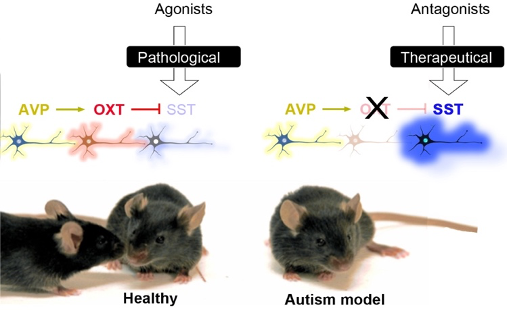LATERAL SEPTUM NEURONS THAT DISABLE SOCIABILITY IN AUTISM
Treatment of autism spectrum disorders (ASD) is limited and drugs like risperidone and aripiprazole have serious unwanted effects. Better therapeutics are urgently needed given the rising prevalence of ASD in the general population. Recent clinical trials with the neurohormone oxytocin provided controversial results, and the benefits reported with the similar hormone vasopressin sparked confusion when replicated with an antagonist of vasopressin receptors.
We postulated that mixed clinical effects with these neuropeptides could results from co-dependent actions on neurons driving one behavior while suppressing others for exclusivity of pro- versus anti-social response.
In an article published in the journal Cell Reports Medicine, the team “Stress, hormones and plasticity” headed by Freddy Jeanneteau has identified neurons located in the lateral septum that respond to the sequential release of vasopressin and then oxytocin as per degree of peer affiliation with strangers and mates. On the one hand, these are somatostatinergic inhibitory neurons expressing oxytocin receptors whose activation stimulates a signaling pathway targeting GABAB receptors. On the other hand, vasopressin stimulation involves GABAergic neurons whose release of GABA activates GABAA receptors located on somatostatinergic neurons. Together, oxytocin and vasopressin suppress the somatostatinergic drive specifically cued to the termination of social contacts. Injection of somatostatin caused premature termination of social contacts while an antagonist prolonged the duration of social contacts, similar to the effects of vasopressin and oxytocin treatments. But in ASD modeling animals, somatostatin neurons are depleted of oxytocin receptors causing a hypersomatostatinergic state, resistance to oxytocin treatment and premature termination of social contacts.
The results strongly advise for the utilization of combination therapy with both oxytocin and vasopressin to fully suppress unchecked hyper-somatostatinergic state associated with the ASD phenotype. More importantly, somatostatin antagonism is a viable alternative to vasopressin and oxytocin therapies for treating social deficits in neuropsychiatric diseases characterized by endocrine resistance due to oxytocin receptor depletion in the brain.
This work was accepted for publication in Cell Reports Medicine.

Experimental autism with hypersomatostatinergic state in the lateral septum triggers the termination of social contacts. This is due to oxytocin receptor depletion in somatostatin neurons which prevents inhibitory control by oxytocin (release cued to mates) but also by its co-regulator vasopressin (release cued to strangers). By bypassing oxytocin resistance and vasopressin dependency, SST antagonism is a viable therapeutic option for social disabilities in autism.


